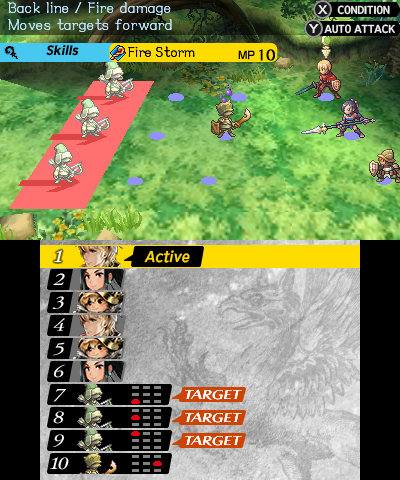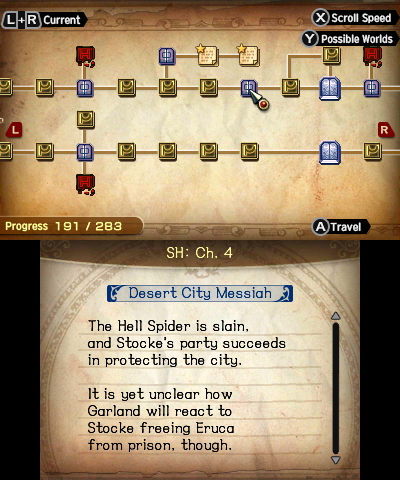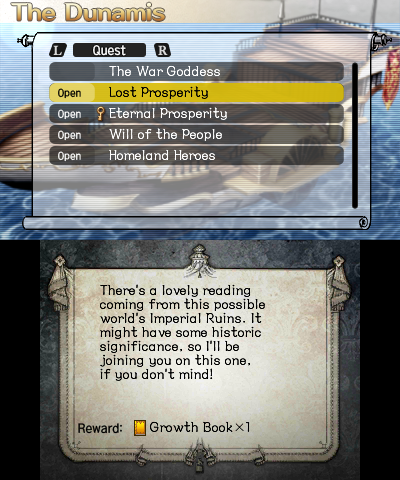- Genre: JRPG
- Platform: 3DS
- Original Released on: DS
TL;DR
- Still one of the more interesting JRPG battle systems I’ve ever seen with a heavy emphasis on moving and grouping enemies for AoE attacks.
- Good selection of new content for returning players that is well integrated into the mainline story for new players.
- Doesn’t do anything to inherently fix the grind of the original game, but a new Friendly difficulty opens up some interesting potential for JRPGs to pull from.
Admittedly this is a game I shelved the first time around. It’s not that it was bad; in fact its battle system alone makes this game at least worth checking out. However, in the base difficulty this game is EXTREMELY grindy. Fights are mechanically interesting, but can be slow. Damage is large, so healing is often necessary. Healing burns mana, so items are necessary. Items cost money, so money is necessary. Running out of money necessitates more fighting, so you’re stuck in a loop. Generally speaking, it wasn’t even the bosses that were an inherent problem. It was usually just getting to the point where taking out trash in a new chapter felt reasonable without being a huge risk.
So, does the remake solve that? Nope. Does it do anything to really change the game mechanically? Nope. What it does so is add a new Friendly difficulty that is entirely too easy, but brings in some really interesting mechanics to eliminate the need to grind, and is something I hope to see more games explore in the future.

Since this is a JRPG, I feel like I should start off with combat as it was and still is one of the strong points of this game. Radiant Historia pretty cleverly mixes pretty standard JRPG mechanics with a very tactics-styled positioning system into a quick hitting system where the focus becomes trying to maximize stacking of enemies to allow for multiple hits in one attack.
While the core system has your standards (basic attacks, magic attacks, heals, buffs/debuffs, etc), the real core of the system is in repositioning attacks. Pretty early on all the party characters gain attacks that can move enemies around the board. Enemies that are repositioned into each other are then treated as single units for purposes of attack location, allowing for stacked enemies to all be damaged at one time. This then combines with turn order manipulation, either via speed stat, skills to delay turns, etc to chain friendly attacks, and the real focus comes down to basically trying to stack all enemies at once into a single spot and unleashing hell.
As an example, in the screenshot above, I could use Fire Storm to move the whole back line forward, then use line attacks to kill all 4 enemies at once. Alternatively, I could push the front guy back and do the same against the full back line. Other bonuses come into play (front line takes more damage but also does more damage) to allow for more nuanced strategies over the course of a full fight, but the core is in smart positioning for maximizing damage output.
All of these things elevate what would be a typically standard battle system into something truly special, and even in the grindy areas of the game allow for a lot of fun, particularly with the on-the-go nature of the DS family, allowing for a few interesting battles in a few minutes if that’s all the time the player has.

On the story side, this game is entirely about manipulation of time. The game takes place in a split timeline where you have unlimited attempts to set things right, so dying is really not a huge deterrent. However, each timeline has its own problems to solve, and problems that can unblock progress in the other timeline. In addition, there are distinct losing points (red nodes in the above) where the story progress effectively ends, forcing a restart at the nearest chapter.
Overall this works as a good way for the player to have freedom in their choices. Hit a block in the story and can’t figure it out? Find a spot where a new side path can be completed elsewhere in the timeline, and you might be able to unblock things. Difficulty spike means you need to level up a bit? Jump back to an earlier point in the timeline where battle grinding is more practical. The freedom of choice to jump around like that is a thing that a lot of JRPGs don’t really give, and its an effective tool here when combined with the story background of jumping through time.

This is all maintained really well in the remake, and is padded by some additional new content both in the main timeline and in a new set of side stories labeled as possible histories. For returning players, this is the bulk of the content that they’ll be coming back for. While these aren’t story bits tied to the main line, they’re an interesting look at what could have been within the overall structure of the world. In addition, the woman running the Dunamis also provides a path to learning more about the history of the world the game takes place in, opening a path for some more interesting lore. However, this alone wouldn’t have been enough for me to come back for more grinding. The addition of Friendly mode was the real thing that brought me back.
The entire idea behind Friendly mode is that it provides a path for the player to skip unimportant battles. In the base game, if the player hits a unit on the field, they gain a preemptive strike to allow them to attack first in battle. While this was helpful, it didn’t eliminate the need to spend resources while grinding. Friendly mode takes this one gigantic step further. In this mode, if the user strikes an enemy in the field, they automatically win the battle, gain XP, and gain all relevant resources that would have normally dropped. The end result of this is that the only combat the player ever takes place in will be for boss battles and story-relevant battles, leaving the rest of the game to exist as a way to enjoy the story and figure out the time-based puzzles.
I’ve seen this mode described as the visual-novel version, and I think that’s about as close to accurate as I could come up with. The game becomes significantly shorter in this mode, and the story comes at a much more rapid pace, so I found myself being significantly more involved in enjoying the story as it came at me, rather than having huge grinding delays between story segments. It then felt even more important to be in battle, as it always felt like it served the story at that particular time, rather than being a consequence of needing to level up the party.
End of the day, I think this is something that more JRPGs should explore as a core feature going forward. The reduction in grind meant the game flowed much quicker and I never lost the story. If I WANTED to battle, I could also simply run into an enemy on the field and start battle, but it was a conscious choice. The one real downfall of Friendly mode is that it was also combined with an extremely lowered difficulty. Ideally, the Friendly mechanics would be combined with boss battles that are tied to the selected difficulty, leaving the challenge there where the player wants with the streamlined battle selection. However, for a returning player simply wanting to see the story, I think the lowered difficulty ended up being pretty ideal for me in most areas.
I guess this is a pretty easy one for me. This was a great game when it originally came out, and it’s a great game now. The problems that existed are still there, so if you’re a new player be ready for some grinding. If you’re a returning player, this is a <20 hour run with the addition of Friendly mode, allowing for the focus to be on enjoying the narrative. However, I think there’s enough there for anyone to enjoy to generally recommend it, assuming of course you haven’t sold off your 3DS.

